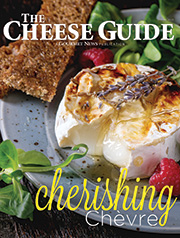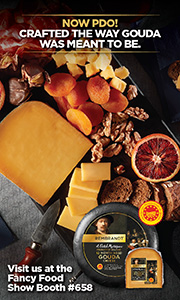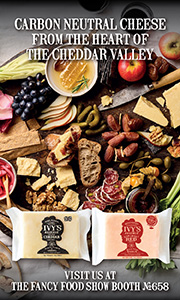
Specialty Foods Offer Growth Potential for Independent Grocers
By Lorrie Baumann
Independent grocers had more or less overlooked specialty foods for a long time, but now they’re looking at the category as a way to help them compete with younger, Internet-savvy customers who are demanding more from their local grocers. “Specialty was kind of overlooked for a time,” said Kurt Rodhe, President of Rodhe’s IGA Marketplace in Chicago, Illinois. “That’s totally changed…. Things we used to consider not conventional are becoming more conventional. The lines are blurred…. Everybody’s playing in this game now.”
“We’re not selling Cheerios like we used to,” he added. “We’ve got to pick that up with something else.”
More than half of American consumers are buying specialty foods, with core customers in the age range of 25 to 44, and about 75 percent of specialty food volume is being sold in brick-and-mortar stores. Younger consumers, the Z Generation, are active in the specialty foods category at rates approaching 80 percent of them, said Dan Funk, Chief Supply Chain and Merchandising Officer for Associated Wholesale Grocers. “That’s a huge number,” he said. “Here’s a generation that’s just coming into the category and they’re entering the category at almost 80 percent.”
The specialty food industry is now a $140 billion business and it’s growing at a rate from 12 to 18 percent – and that’s not because of price increases, according to Phil Kafarakis, President of the Specialty Food Association. “This is going to be a $2 billion business in the next four years,” he said.
There’s no longer a consumer who only buys conventional product, and any consumer is likely to buy a specialty product sometimes, said Stephen Corradini, Chief Merchandising Officer for Kings Food Markets and Balducci’s Food Lovers Market. That applies particularly to the shopper who’s buying for other members of the household as well as for himself, he added. “The intent of the purchase occasion is something to be mindful of….. Maybe they’re willing to try something new, or maybe they’ll keep two in the refrigerator.”
Funk urged the grocers in his audience during the National Grocers Association’s NGA Show to venture into the specialty foods space by picking five to eight categories that could be deployed in underused or underperforming space. “Think of specialty, natural and organic for your store as a key to growth,” he said. “While it’s coming from a smaller base, this is one of the only areas in the store where there’s been consistent growth year over year for multiple years in a row, and it’s an area that, in many instances, is undersized in our stores.”
Growing ethnic diversity and consumer concerns about their health and wellness are helping to drive growth in the specialty foods category, Funk said. “Food is really becoming medicine,” he added. “The self-care side of the business is critically important.”
Consumers are demanding ethnic foods, clean ingredient decks and the organic label, Funk said: “Organic has always been a staple of this category…. If you’re going to land in this space, and specialty food is going to have space in your store, organic is a key and a core staple.” About 75 percent of specialty food categories have some organic offerings. “It’s a $50 billion business,” he said, adding that 82 percent of households purchased something organic over the course of the past year, and 14 percent of fresh produce sales are for organic products.
There are other areas of growth within the specialty foods category. Over the last several years, the appearance of multiple refrigerated items have really driven the overall category growth. Dairy and frozen products are a good insulator from the online threat, Funk said. “Think of dairy and frozen as a competitive advantage to that e-commerce channel. It’s extremely expensive; nobody’s figured it out, and there’s high share and high growth in these areas.”
Ethnic categories, plant-based categories and products that appeal to the health-focused consumers who are practicing special diet regimens also offer potential. “These would be major areas in the store that you would be looking at planning for remodels and adjustments of size and space in the store in the coming years,” Funk said.
The biggest sales categories within specialty food include cheese; frozen meat products; snacks and chips; various different types of confectionery products; and yogurt, kefir and frozen desserts, Funk said. Yogurt, frozen desserts and refrigerated entrees, with 40 percent growth, are big categories. Water and solution-based water beverages as well as protein snacks are also experiencing very high growth. With respect to the meat snacks, the normal average ring is anywhere between $5 and $15, Funk said. “Most of those items are generating over a 30 margin, and most of those items are highly impulsive,” he added. “Protein snacks and a lot of these refrigerated items are a great opportunity for you to build basket.”
NGA Show Draws Independent Grocers to San Diego
By Lorrie Baumann
More than 3,500 independent grocery retailers and wholesalers gathered in San Diego Feb. 23–26 to explore issues affecting the grocery industry, to discuss ideas for how they’re going to remain relevant and competitive in an omnichannel environment and to hear success stories from their colleagues who have winning strategies in place in their stores. This was National Grocers Association President and Chief Executive Officer Peter Larkin’s final time to preside at the gathering before he retires at the end of this year. Larkin has served the association for nine years.
Richard Volpe, a professor in Cal Poly’s Agribusiness Department and a member of the Food Industry University Coalition, brought a group of students to the NGA Show to compete in the NGA’s annual Student Case Study Competition and to participate in the mentoring opportunities offered to them by the association. To prepare for the competition, his agricultural economics and food marketing students had spent four months researching the economics of getting food from the field to the fork and had prepared to present that research to the association as part of their capstone projects for their degrees, he said.
This year’s Student Case Study Competition was around the topic of how independent grocers can encourage Millennials, especially those from diverse backgrounds, to join their ranks. The multi-day judging event evaluated presentations by 13 university student groups and concluded with Saint Joseph’s University and Western Michigan University facing off in a final round in which Saint Joseph’s took top honors.
For Warren Brown, Vice President of Operations at Commerce Quality Foods, a retail grocer with eight stores — six in Georgia and two in South Carolina — the event was an educational opportunity that he hopes will help him attract new customers. “A lot of our customer base is older. We’ve got to embrace that younger generation to have a new customer base,” he said. “We need to embrace technology in the grocery business, especially in the independent world, or we’re going to be left behind.”
He noted that many of the 400 vendors in the 57,000 square-foot exhibit hall were offering new technology that can help him do that, and his next step may be finding new meat-wrapping equipment that can help him add more deli offerings into his stores. Brown foresees that prepared foods will be playing a greater role in his stores in the future, and while he’s already dipped a toe into that water with a smoker and a hot and cold bar, he’s anticipating that his stores will need to go further. “That’s kind of the first wave before we go into full deli,” he said.
Meat was on Cameron Harsh’s mind, too. He’s the Farm Campaign Manager for World Animal Protection U.S., and he’d come to San Diego to ask independent grocers to commit to sourcing their meat from farmers and ranchers who raise and harvest their animals humanely. Consumers are demanding those welfare certifications, and he found grocers who are eager to make sure that they’re meeting their shoppers’ expectations. “There’s a lot of interest among independent retailers to have their fingers on the pulse of their customers and to recognize that their customers are asking for high-welfare meat,” he said. “They’re recognizing that meat is a way to differentiate from the big box stores.”
Fresh-cut meat is a real point of pride for Joe Jester, from Hamilton, Ohio, who believes that the custom cuts that he offers in his Brookville IGA store offer his shoppers both better texture and better flavor that they can get in the pre-packaged meat they’d buy in a chain store where the meat was cut and wrapped in a central processing facility. “We don’t have to do anything artificial to it. We cut it and present it,” he said. “Custom-cut meat is a real opportunity for independents to showcase their meat departments.”
He recently bought two new stores, and the first thing he did was double the size of their deli departments so the markets can offer their customers more prepared offerings like sandwiches, deviled eggs, pasta bowls and hot pizza. “It looks like it’s working very successfully,” he said. “People’s most valuable commodity right now is time, so anything you can do to save them time is appreciated.”
While he feels that he’s got that point pretty well figured out, he came to the NGA Show hoping for some guidance on what he should do next with social media. He’s got Facebook accounts, and he’ll probably do Twitter next, but he’s been letting other grocers iron out the wrinkles on click-and-collect and other strategies for competing with online marketers before he adopts them, and he thinks now might be the time to start figuring out more of that. “If you’re not keeping up with technology, you’re going to be behind,” he said.
David Masterson, Director of Information Technology for Bristol Farms, came to the event to explore how Bristol Farms might strengthen its level of competition in the grocery industry with artificial intelligence, click-and-collect services and various omnichannel methods. “Consumers are migrating towards digital,” he said. “Walmart and Ralph’s are strengthening that part of their business, and we need to strengthen that as well to make sure we’re able to compete in the future.”
Chris Smith, the Vice President of Information Technology for Homeland Acquisition Corporation, which is headquartered in Oklahoma City, Oklahoma, and operates stores under the Homeland, United Supermarkets and Cash Savers banners in four states, was also searching the exhibit hall for vendors who could help his company compete in the technology arena. “The technology side of the NGA Show seems to grow every year,” he noted. For him, this show offered a particular advantage because it presented him with an opportunity to catch all of his vendors and prospective vendors in one place and to catch up with his colleagues in independent grocery retailing. “Some of which we see only once a year,” he said. “They’re resources where we can bounce things off each other.”
Tom Ruggiero Joins The Forest Farmers
The Forest Farmers has named food industry veteran Tom Ruggiero as National Sales Director for its recently launched line of USDA Organic tree saps and syrups sourced from a variety of tree species.
Ruggiero has responsibility for growing sales of the New Leaf Tree Syrups™ line with food and beverage producers looking for alternative sweeteners, chefs and foodservice for kitchen and tabletop use, and at retail, said Mike Farrell, co-Founder and Chief Executive Officer of The Forest Farmers.
Ruggiero has more than 30 years of experience across diverse channels in the food industry and also in the maple industry. He has worked with large enterprises, including as the brand and private label category manager for A&P and Shoprite, and has managed sales teams across North America for large brands such as Pomi, Beech-Nut, Godiva, Betty Crocker and Parmalat.
Ruggiero also has facilitated the successful launch of three new brands. Most recently, he served as director of national sales for Crown Maple and Madava Sugar Maple since 2015 and as General Manager for Galicia Food & Drink since 2014. He is a graduate of the University of Oklahoma with bachelor degrees in public administration and geology.
New Leaf USDA organic tree saps and syrups are sourced from a variety of tree species, some of which will be available commercially for the first time. Maple and birch sap and syrup are available year-round. With this spring’s harvest, syrup from beech, basswood and walnut trees will be available for the first time in limited quantities. Syrup blends of maple with birch, walnut, beech or other tree species also will be available as will maple syrups infused with forest-sourced botanicals, mushrooms, berries, and other ingredients.


















